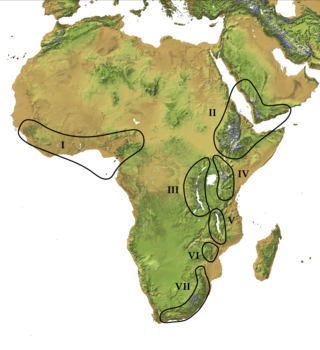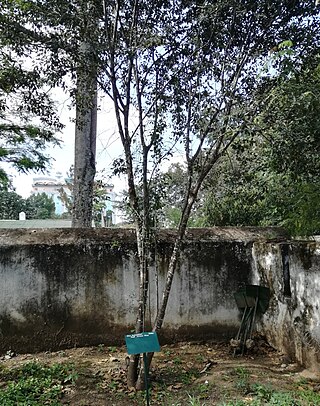
The olive, botanical name Olea europaea, meaning 'European olive', is a species of small tree or shrub in the family Oleaceae, found traditionally in the Mediterranean Basin. When in shrub form, it is known as Olea europaea'Montra', dwarf olive, or little olive. The species is cultivated in all the countries of the Mediterranean, as well as in Australia, New Zealand, North and South America and South Africa. It is the type species for its genus, Olea. The tree and its fruit give their name to the Oleaceae plant family, which also includes species such as lilac, jasmine, forsythia, and the true ash tree.

A woodland is, in the broad sense, land covered with woody plants, or in a narrow sense, synonymous with wood, a low-density forest forming open habitats with plenty of sunlight and limited shade. Some savannas may also be woodlands, such as savanna woodland, where trees and shrubs form a light canopy.
Ironwood is a common name for many woods or plants that have a reputation for hardness, or specifically a wood density that is heavier than water, although usage of the name ironwood in English may or may not indicate a tree that yields such heavy wood.

Olea is a genus of flowering plants in the family Oleaceae. It includes 12 species native to warm temperate and tropical regions of the Middle East, southern Europe, Africa, southern Asia, and Australasia. They are evergreen trees and shrubs, with small, opposite, entire leaves. The fruit is a drupe. Leaves of Olea contain trichosclereids.

Olea capensis, the black ironwood, is an African tree species in the olive family Oleaceae. It is widespread in sub-Saharan Africa: from the east in Somalia, Ethiopia and Sudan, south to the tip of South Africa, and west to Cameroon, Sierra Leone and the islands of the Gulf of Guinea, as well as Madagascar and the Comoros. It occurs in bush, littoral scrub and evergreen forest.

The Afromontane regions are subregions of the Afrotropical realm, one of the Earth's eight biogeographic realms, covering the plant and animal species found in the mountains of Africa and the southern Arabian Peninsula. The Afromontane regions of Africa are discontinuous, separated from each other by lower-lying areas, and are sometimes referred to as the Afromontane archipelago, as their distribution is analogous to a series of sky islands.

Gymnosphaera capensis, synonyms Alsophila capensis and Cyathea capensis, is a regionally widespread and highly variable species of tree fern. It is indigenous to Southern Africa and South America.

Adenium obesum, more commonly known as a desert rose, is a poisonous species of flowering plant belonging to the tribe Nerieae of the subfamily Apocynoideae of the dogbane family, Apocynaceae. It is native to the Sahel regions south of the Sahara, tropical and subtropical eastern and southern Africa and also the Arabian Peninsula. Other names for the flower include Sabi star, kudu, mock azalea, and impala lily. Adenium obesum is a popular houseplant and bonsai in temperate regions.

The cardinal woodpecker is a widespread and common resident breeder in much of sub-Saharan Africa. It occurs in a wide range of habitats, ranging from dense forest to thorn bush. It is fairly vocal and is easily identified by its call notes. The sexes are distinguishable by their head patterns.

Olea europaea subsp. cuspidata is a subspecies of the well-known olive tree, which until recently was considered a separate species and is still mentioned as such in many sources. Native to northeast of Africa and the drier parts of subtropical Asia, it has various common names, including wild olive, African olive, brown olive and Indian olive.

The fan-tailed widowbird, also known as the red-shouldered widowbird, is a species of bird in the family Ploceidae, which is native to grassy and swampy areas of the tropical and subtropical Afrotropics.

The African broadbill, also known as the black-capped broadbill or Delacour's broadbill, is a species of bird in the sub-oscine family Calyptomenidae.

Cassia abbreviata, commonly known as the sjambok pod or long-tail cassia, is a mostly tropical tree species in the genus Cassia, which is native to Africa.

Charaxes jahlusa, the pearl-spotted emperor or pearl spotted charaxes, is a butterfly of the family Nymphalidae found in southern Africa.

Vachellia reficiens, commonly known as red-bark acacia, red thorn, false umbrella tree, or false umbrella thorn, is a deciduous tree or shrub of the pea family (Fabaceae) native to southern Africa, often growing in an upside-down cone shape and with a relatively flat crown.

The Ficus sansibarica, known as knobbly fig, is an African species of cauliflorous fig. It is named after Zanzibar, where Franz Stuhlmann discovered it in 1889. They often begin life as epiphytes, which assume a strangling habit as they develop. They regularly reach 10 m, but may grow up to 40 m tall as forest stranglers.

Vachellia robusta, the splendid thorn, is an Afrotropical tree species.

Olea capensis subsp. macrocarpa is a subspecies of tree of the family Oleaceae. Like the related species Olea welwitschii, it grows in sandy desert regions of Kenya, Tanzania and Uganda. It is an inconspicuous plant that does not attain great height, in contrast to O. welwitschii which can attain a height of 25 metres.

Gardenia volkensii, commonly known as bushveldt gardenia or Transvaal gardenia, is a species of plant in the family Rubiaceae native to southern Africa.


















